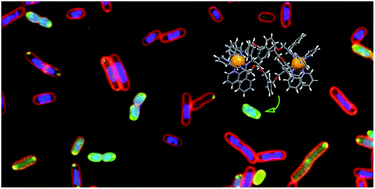Metallohelices that kill Gram-negative pathogens using intracellular antimicrobial peptide pathways†
Abstract
A range of new water-compatible optically pure metallohelices – made by self-assembly of simple non-peptidic organic components around Fe ions – exhibit similar architecture to some natural cationic antimicrobial peptides (CAMPs) and are found to have high, structure-dependent activity against bacteria, including clinically problematic Gram-negative pathogens. A key compound is shown to freely enter rapidly dividing E. coli cells without significant membrane disruption, and localise in distinct foci near the poles. Several related observations of CAMP-like mechanisms are made via biophysical measurements, whole genome sequencing of tolerance mutants and transcriptomic analysis. These include: high selectivity for binding of G-quadruplex DNA over double stranded DNA; inhibition of both DNA gyrase and topoisomerase I in vitro; curing of a plasmid that contributes to the very high virulence of the E. coli strain used; activation of various two-component sensor/regulator and acid response pathways; and subsequent attempts by the cell to lower the net negative charge of the surface. This impact of the compound on multiple structures and pathways corresponds with our inability to isolate fully resistant mutant strains, and supports the idea that CAMP-inspired chemical scaffolds are a realistic approach for antimicrobial drug discovery, without the practical barriers to development that are associated with natural CAMPS.

- This article is part of the themed collection: 2019 Chemical Science HOT Article Collection


 Please wait while we load your content...
Please wait while we load your content...